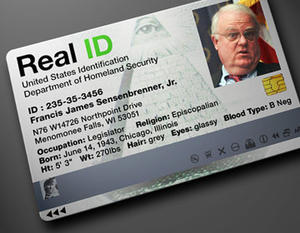Real IDReal ID pushed back a third time
To prevent massive air travel disruptions, DHS has postponed the effective date of the Real ID Act for the third time until 15 January 2013. Real ID; DHS has met congressional and state opposition in attempting to get the Real ID Act underway; sixteen states have passed laws forbidding them to comply with Real ID, and eight states have enacted resolutions effectively boycotting it altogether

Mockup of RealID card // Source: infiniteunknown.net
To prevent massive air travel disruptions, DHS has postponed the effective date of the Real ID Act for the third time until 15 January 2013. Real ID would add biometric data and RFID capabilities to driver’s licenses. The Real ID Act was first postponed March 2007 in hopes of gaining more state support, and just a year later, the implementation deadline was moved to 2011.
DHS has met congressional and state opposition in attempting to get the Real ID Act underway. A chart published by the National Conference of State Legislatures listed sixteen states with laws forbidding them to comply with Real ID and eight states that have enacted resolutions effectively boycotting it altogether.
In the event regulations take full effect, residents of the opposing twenty-four states would not be able to use their driver’s license to fly or to enter a federal building such as a courthouse, even for jury duty. U.S. passports or military IDs, however, would remain valid forms of identification.
Real ID supporters reacted angrily to the news of the delay — the third to date.
“It is disappointing to me that the Obama administration has chosen to put Americans at risk by having another delay in implementing Real ID,” Representative James Sensenbrenner (R-Wisconsin) said in a statement.
He was joined by three other senior Republicans: House Judiciary Chairman Lamar Smith (R-Texas), Oversight and Government Reform Chairman Darrell Issa (R-California), and Homeland Security Chairman Peter King (R-New York).
Republicans claim that last week’s arrest in Texas of Khalid Aldawsari on charges of terrorism “underscores the importance” of implementing Real ID immediately (“Arrest of Saudi student prompts questions on visa security” 10 March 2011 HSNW).
Backers have defended the program, claiming that Real ID could extend beyond the applications of anti-terror and ID fraud cases. Since Real ID links to state DMV databases, uses a standard bar code that can be digitally scanned, and mandates that original documents such as birth certificates be verified, the Real ID Act has the potential to play a role while purchasing firearms or prescription drugs.
A DHS Rule published under the Federal Register, the daily journal of the U.S. government, reads:
The inability of states to fully comply with the requirements of Real ID by 11 May 2011 is the result of a number of factors, including diminished state budgets caused by the economic downturn and the uncertainty throughout much of the 111th Congress about congressional action…Implementation of Real ID involves a significant financial investment, and, despite the receipt of substantial federal grant funds, a number of states are struggling to come up with the resources necessary to meet the full compliance deadline in these times of budget austerity.
The National Governors Association responded with a statement praising the 2013 extension: “Governors have long said that Real ID, in its current form, is unworkable. That has not changed. Extending the compliance deadline allows states and the federal government more time to find solutions that work. Arbitrary deadlines that only keep people from boarding an airplane do not make the impossible possible.”
Yesterday, an Iowa House committee approved anti-Real ID legislation by a 22-1 vote, and the Florida legislature has recently held a hearing on the topic.
Without the extension, air travelers from non-Real ID states might have been subjected to delays, enhanced security screening, and possible denials to board.
In addition, driver’s licenses from non-Real ID states could no longer be used to access “federal facilities,” including military academies, the Pentagon, the Treasury Department, the U.S. Capitol, Veterans Affairs hospitals, and some federal courthouses.
The Real ID Act was signed on 11 May 2005 by then-President Bush after a bipartisan episode in Congress. The Act was attached to war spending and tsunami relief and approved by the senate with a vote of 368 to 58. Real ID cleared the House by a 261-161 vote as a standalone bill without hearings or debate.
